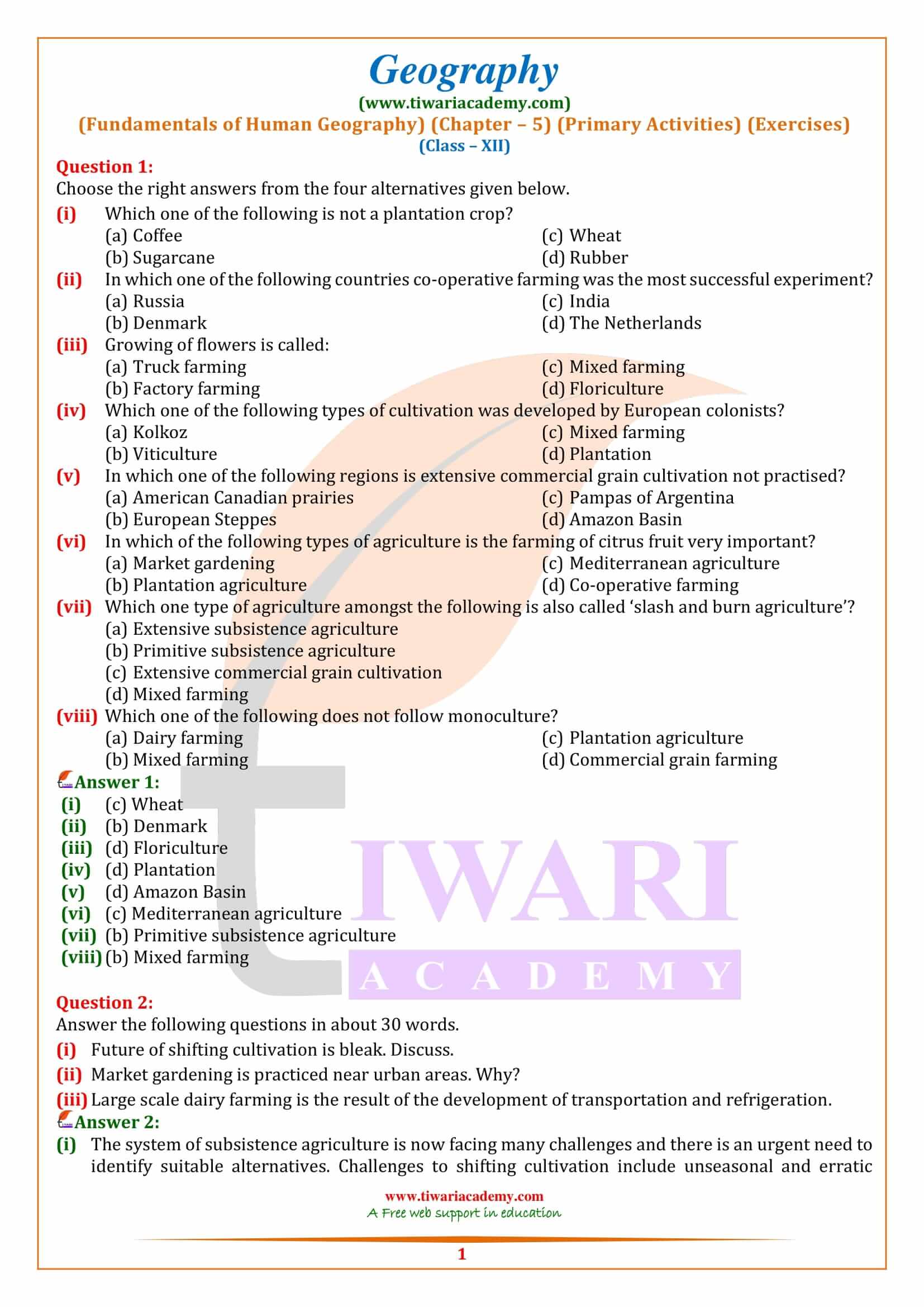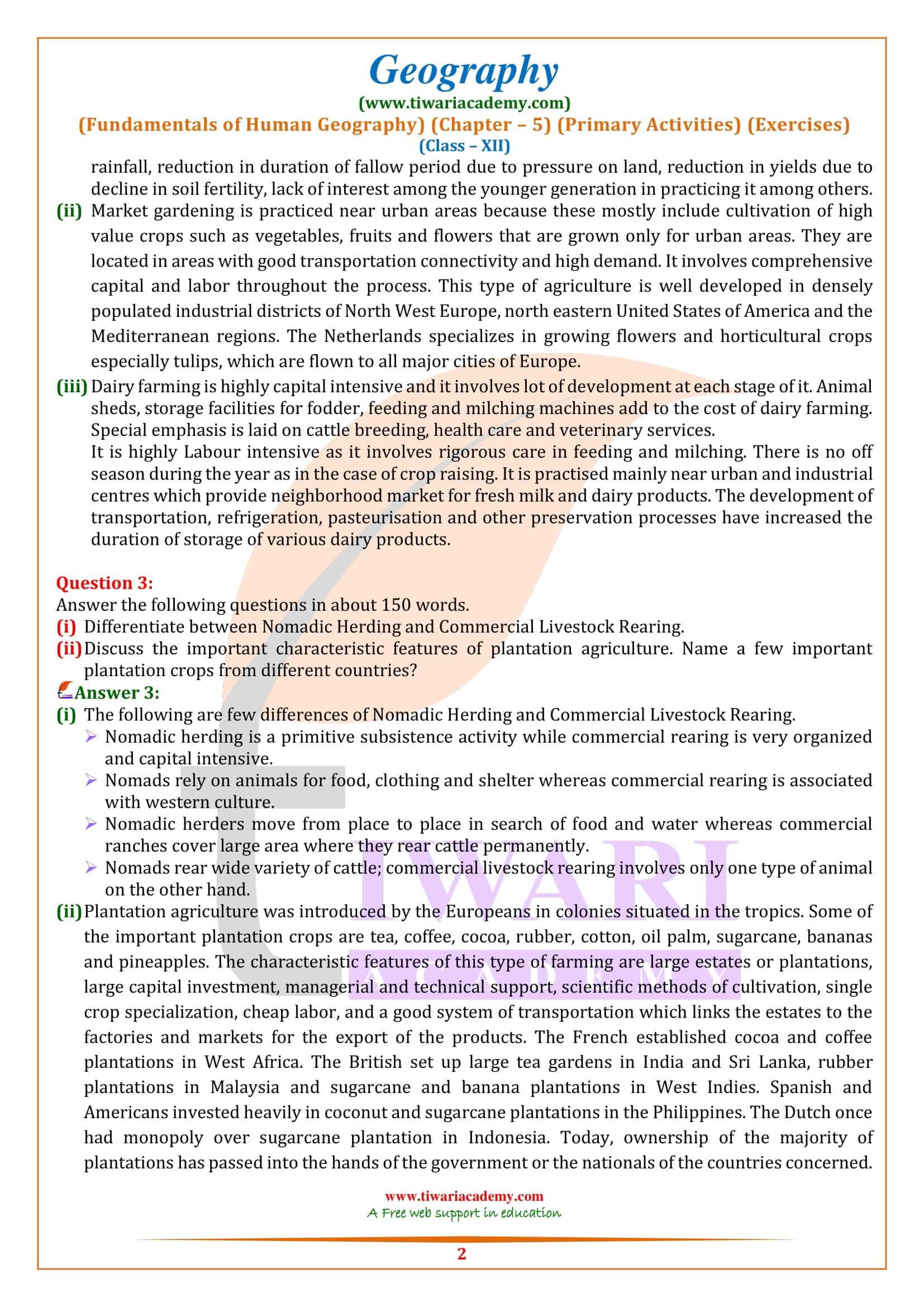NCERT Solutions for Class 12 Geography Chapter 5 Primary Activities in English and Hindi Medium updated for session 2025-26. Get the help in class 12 Geography Part 1 Fundamentals of Human Geography unit 3 chapter 5 question answers, MCQ and extra practice questions.
NCERT Solutions for Class 12 Geography Chapter 5
Class 12 Geography Chapter 5 Primary Activities Question Answers
Future of shifting cultivation is bleak. Discuss.
The system of subsistence agriculture is now facing many challenges and there is an urgent need to identify suitable alternatives. Challenges to shifting cultivation include unseasonal and erratic rainfall, reduction in duration of fallow period due to pressure on land, reduction in yields due to decline in soil fertility, lack of interest among the younger generation in practicing it among others.
Class 12 Geography Chapter 5 MCQ
Which one of the following is not a plantation crop?
In which one of the following countries co-operative farming was the most successful experiment?
Growing of flowers is called
Which one of the following types of cultivation was developed by European colonists?
Market gardening is practiced near urban areas. Why?
Market gardening is practiced near urban areas because these mostly include cultivation of high value crops such as vegetables, fruits and flowers that are grown only for urban areas. They are located in areas with good transportation connectivity and high demand. It involves comprehensive capital and labor throughout the process. This type of agriculture is well developed in densely populated industrial districts of North West Europe, north eastern United States of America and the Mediterranean regions. The Netherlands specializes in growing flowers and horticultural crops especially tulips, which are flown to all major cities of Europe.
Class 12 Geography Chapter 5 MCQs with Answers
In which one of the following regions is extensive commercial grain cultivation not practised?
In which of the following types of agriculture is the farming of citrus fruit very important?
Which one type of agriculture amongst the following is also called ‘slash and burn agriculture’?
Which one of the following does not follow monoculture?
Large scale dairy farming is the result of the development of transportation and refrigeration.
Dairy farming is highly capital intensive and it involves lot of development at each stage of it. Animal sheds, storage facilities for fodder, feeding and milching machines add to the cost of dairy farming. Special emphasis is laid on cattle breeding, health care and veterinary services.
It is highly Labour intensive as it involves rigorous care in feeding and milching. There is no off season during the year as in the case of crop raising. It is practised mainly near urban and industrial centres which provide neighborhood market for fresh milk and dairy products. The development of transportation, refrigeration, pasteurisation and other preservation processes have increased the duration of storage of various dairy products.
Differentiate between Nomadic Herding and Commercial Livestock Rearing.
The following are few differences of Nomadic Herding and Commercial Livestock Rearing:
- Nomadic herding is a primitive subsistence activity while commercial rearing is very organized and capital intensive.
- Nomads rely on animals for food, clothing and shelter whereas commercial rearing is associated with western culture.
- Nomadic herders move from place to place in search of food and water whereas commercial ranches cover large area where they rear cattle permanently.
- Nomads rear wide variety of cattle; commercial livestock rearing involves only one type of animal on the other hand.
Discuss the important characteristic features of plantation agriculture. Name a few important plantation crops from different countries?
Plantation agriculture was introduced by the Europeans in colonies situated in the tropics. Some of the important plantation crops are tea, coffee, cocoa, rubber, cotton, oil palm, sugarcane, bananas and pineapples. The characteristic features of this type of farming are large estates or plantations, large capital investment, managerial and technical support, scientific methods of cultivation, single crop specialization, cheap labor, and a good system of transportation which links the estates to the factories and markets for the export of the products.
The French established cocoa and coffee plantations in West Africa. The British set up large tea gardens in India and Sri Lanka, rubber plantations in Malaysia and sugarcane and banana plantations in West Indies. Spanish and Americans invested heavily in coconut and sugarcane plantations in the Philippines. The Dutch once had monopoly over sugarcane plantation in Indonesia. Today, ownership of the majority of plantations has passed into the hands of the government or the nationals of the countries concerned.



